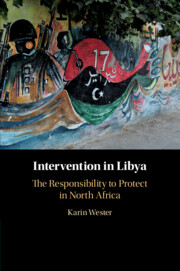Book contents
- Intervention in Libya
- Intervention in Libya
- Copyright page
- Dedication
- Epigraph
- Contents
- Preface
- Maps
- Introduction
- 1 The Origin of the Responsibility to Protect
- 2 Authority Based on Protection in a Historical Context
- 3 Libya and the Era of Qadhafi’s Rule
- 4 The Libyan Uprising and the International Response, February 15–26, 2011
- 5 The Libyan Uprising and the International Response, February 26–March 17, 2011
- 6 Operation Odyssey Dawn
- 7 Operation Unified Protector, NATO, and the UN
- 8 A Divided International Community Confronts a Divided Libya
- 9 Lessons to Be Learned
- Epilogue
- Select Bibliography
- Index
Epilogue
Published online by Cambridge University Press: 28 February 2020
- Intervention in Libya
- Intervention in Libya
- Copyright page
- Dedication
- Epigraph
- Contents
- Preface
- Maps
- Introduction
- 1 The Origin of the Responsibility to Protect
- 2 Authority Based on Protection in a Historical Context
- 3 Libya and the Era of Qadhafi’s Rule
- 4 The Libyan Uprising and the International Response, February 15–26, 2011
- 5 The Libyan Uprising and the International Response, February 26–March 17, 2011
- 6 Operation Odyssey Dawn
- 7 Operation Unified Protector, NATO, and the UN
- 8 A Divided International Community Confronts a Divided Libya
- 9 Lessons to Be Learned
- Epilogue
- Select Bibliography
- Index
Summary
In the fall of 2013, Tripoli seemed a place of relative peace and calm. From the Corniche, speedboats could be seen navigating the Mediterranean Sea in the distance. In some squares, playgrounds and merry-go-rounds had emerged, a comparative novelty for which at first families had reportedly lined up. From stores, music sounded onto the streets, and at night young men made “wheelies” with their cars in the center of the city. Although walls were covered with posters and graffiti of “martyrs” who died in 2011, and many buildings – such as Qadhafi’s former compound Bab al-Aziziya – were still in ruins, a number of quaint squares with modern coffee bars and outdoor terraces were more reminiscent of northern Italy than of a state just emerging from a civil war.
- Type
- Chapter
- Information
- Intervention in LibyaThe Responsibility to Protect in North Africa, pp. 316 - 322Publisher: Cambridge University PressPrint publication year: 2020

